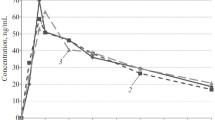Abstract
The effects on heart rate, R-T' interval, and mean arterial blood pressure were studied in seven healthy male volunteers after intravenous (1 and 2 mg/kg) and oral (3 and 6 mg/kg) administration of the quinidine-like antiarrhythmic disopyramide phosphate, 4-diisopropylamino-2-phenyl-2-(2-pyridyl)butyramide phosphate. The left ventricular ejection time was measured after intravenous administration of 2 mg/kg of drug. Simultaneously the plasma concentrations and urinary excretion of the parent drug and its main metabolite, the monodealkylated product, were monitored as a function of time. Heart rate increases of 20% were observed at 2 mg/kg i.v. and 6 mg/kg p.o. and peaked at 0–4 min and 2 hr after administration, respectively. R-T' interval increases of 40% and 9% were observed at 2 mg/kg and 1 mg/kg i.v., respectively, and peaked at 0–2 min after administration. R-T' interval increases of 12% and 4% were observed at 6 mg/kg and 3 mg/kg p.o., respectively, and peaked at 2.5 hr. The ejection time index was unchanged, and although a 5–10% increase in the mean arterial blood pressure was observed in the 11 hr after administration, there was no pattern consistent with size or mode of administration of the four different dosages.
Similar content being viewed by others
References
B. Befeler, A. Castellanos, Jr., D. E. Wells, M. C. Vagueiro, B. K. Yeh, and R. J. Myerburg. Electrophysiological effects of disopyramide phosphate: A new antiarrhythmic agent.Am. J. Cardiol. 35:282–287 (1975).
J. F. Conway, K. Bottomley, E. J. Wakeley, and R. S. Dugg. Disopyramide in cardiac arrhythmias—An initial appraisal.J. Int. Med. Res. 1:107–114 (1973).
J. Desruelles and A. Gerard. Indications et resultats due disopyramide dans les troubles due rythme cardiaque.Mouvement Ther. 2:95–108 (1970).
J. Granier. Un nouvel antiarythmique: Le disopyramide.Presse Med. 76:1605–1606 (1968).
G. Härtel, A. Louhija, and A. Konttinen. Disopyramide in the prevention of recurrence of atrial fibrillation after electroconversion.Clin. Pharmacol. Ther. 15:551–555 (1974).
M. J. Katz, C. E. Meyer, A. El-Etr, and S. J. Slodki. Clinical evaluation of a new antiarrhythmic agent, SC-7031.Curr. Ther. Res. 5:343–350 (1963).
L. A. Vismara, D. T. Mason, and E. A. Amsterdam. Disopyramide phosphate: Clinical efficacy of a new oral antiarrhythmic drug.Clin. Pharmacol. Ther. 16: 330–335 (1974).
R. S. Dreifus, Z. Filip, D. M. Sexton, and Y. Watanabe. Electrophysiological and clinical effects of a new antiarrhythmic agent: Disopyramide.Am. J. Cardiol. 31: 129 (1973).
P. P. Mathur. Cardiovascular effects of a newer antiarrhythmic agent, SC-7031.Curr. Ther. Res. 5:343–350 (1963).
B. K. Yeh, P. K. Sung, and B. J. Scherlag. Effects of disopyramide on electrophysiological and mechanical properties of the heart.J. Pharm. Sci. 62:1924–1929 (1973).
A. Sekyia and E. M. Vaughan Williams. A comparison of the antifibrillatory actions and effects on intracellular cardiac potentials of pronethalol, disopyramide and quinidine.Br. J. Pharmacol. Chemother. 21:473–481 (1963).
R. R. Dean and D. M. Ferguson. Effects of disopyramide on the a-v conduction system.Arch. Int. Pharmacodyn. 190:183–189 (1971).
C. M. Mokler and C. G. Van Arnam. Pharmacology of a new antiarrhythmic agentγ-diisopropylamino-α-phenyl-α-(2-pyridyl)-butyramide (SC-7031).J. Pharmacol. Exp. Ther. 136:114–124 (1962).
C. M. Mokler and R. A. Hillman. Nature of the anticholinergic action of some antiarrhythmic drugs.Pharmacol. Res. Commun. 4:171–178 (1972).
B. Jensen, B. Sigard, and A. Uhrenholt. Hemodynamic effects of intravenous disopyramide in heart failure.Eur. J. Clin. Pharmacol. 8:167–173 (1975).
P. H. Hinderling and E. R. Garrett. Pharmacokinetics of the antiarrhythmic disopyramide in healthy humans.J. Pharmacokin. Biopharm. 4:199–230 (1976).
A. M. Weissler, G. L. Morris, and G. D. White. Left ventricular ejection time index in man.J. Appl. Physiol. 18:919–923 (1963).
A. C. Guyton.Textbook of Medical Physiology, 3rd ed., Saunders, Philadelphia, 1968, p. 198.
D. T. Mason, J. F. Spann, R. Zelis, and E. A. Amsterdam. The clinical pharmacology and therapeutic application of the antiarrhythmic drugs.Clin. Pharmacol. Ther. 11:460–480 (1971).
H. C. Bazett. An analysis of the time relationship of the electrocardiogram.Heart 7:353–360 (1920).
M. Kissin, M. M. Schwarzschild, and M. Bakst. A nomogram for rate correction of the Q-T interval in the electrocardiogram.Am. Heart J. 35:990–992 (1948).
A. M. Weissler, R. G. Peeler, and W. M. Roehll. Relationships between left ventricular ejection time, stroke volume and heart rate in normal individuals and patients with cardiovascular disease.Am. Heart J. 62:367–378 (1961).
D. S. Riggs.The Mathematical Approach to Physiological Problems, Williams and Wilkins, Baltimore, 1963, p. 8.
C. Fisch, S. B. Knoebel, M. Feigenbaum, and K. Greenspan. Potassium and the monophasic action potential, electrocardiogram, conduction and arrhythmias.Progr. Cardiovasc. Dis. 8:387–418 (1966).
E. R. Garrett. In H. P. Kuemmerle, E. R. Garrett, and K. M. Spitzy (eds.),Klinische Pharmakologie und Pharmakotherapie, Urban and Schwarzenberg, Munich, West Germany, 1971, p. 36.
E. R. Garrett, A. J. Ågren, and H. J. Lambert. Pharmacokinetic analysis of receptor site models in multicompartment systems.Int. J. Clin. Pharm. 1:1–14 (1967).
R. R. Dean. In: A seminar on Norpace (disopyramide phosphate), a new antiarrhythmic agent.Angiology 26:98 (1975).
R. Ashman and E. Hull.Essentials of Electrocardiography, 2nd ed., Macmillan, New York, 1941, p. 344.
Author information
Authors and Affiliations
Additional information
Supported in part by Grant No. NIH-RR-82 from the National Institutes of Health, Bethesda, Maryland, and by an unrestricted grant from Searle Laboratories, Skokie, Illinois.
Rights and permissions
About this article
Cite this article
Hinderling, P.H., Garrett, E.R. Pharmacodynamics of the antiarrhythmic disopyramide in healthy humans: Correlation of the kinetics of the drug and its effects. Journal of Pharmacokinetics and Biopharmaceutics 4, 231–242 (1976). https://doi.org/10.1007/BF01063615
Received:
Revised:
Published:
Issue Date:
DOI: https://doi.org/10.1007/BF01063615




